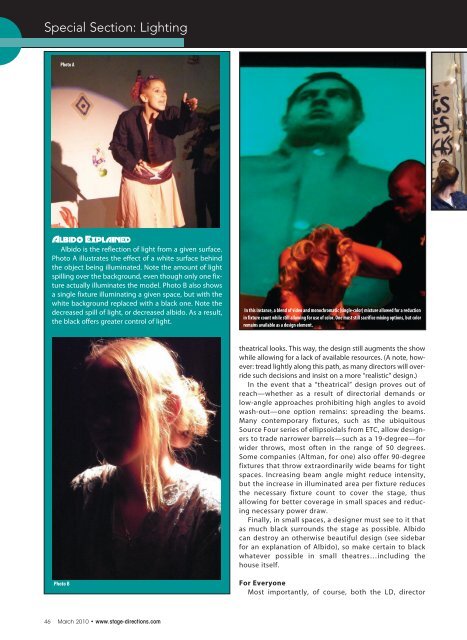Download a PDF - Stage Directions Magazine
Download a PDF - Stage Directions Magazine
Download a PDF - Stage Directions Magazine
You also want an ePaper? Increase the reach of your titles
YUMPU automatically turns print PDFs into web optimized ePapers that Google loves.
Special Section: Lighting<br />
Photo A<br />
Albido Explained<br />
Albido is the reflection of light from a given surface.<br />
Photo A illustrates the effect of a white surface behind<br />
the object being illuminated. Note the amount of light<br />
spilling over the background, even though only one fixture<br />
actually illuminates the model. Photo B also shows<br />
a single fixture illuminating a given space, but with the<br />
white background replaced with a black one. Note the<br />
decreased spill of light, or decreased albido. As a result,<br />
the black offers greater control of light.<br />
In this instance, a blend of video and monochromatic (single-color) mixture allowed for a reduction<br />
in fixture count while still allowing for use of color. One must still sacrifice mixing options, but color<br />
remains available as a design element.<br />
theatrical looks. This way, the design still augments the show<br />
while allowing for a lack of available resources. (A note, however:<br />
tread lightly along this path, as many directors will override<br />
such decisions and insist on a more “realistic” design.)<br />
In the event that a “theatrical” design proves out of<br />
reach—whether as a result of directorial demands or<br />
low-angle approaches prohibiting high angles to avoid<br />
wash-out—one option remains: spreading the beams.<br />
Many contemporary fixtures, such as the ubiquitous<br />
Source Four series of ellipsoidals from ETC, allow designers<br />
to trade narrower barrels—such as a 19-degree—for<br />
wider throws, most often in the range of 50 degrees.<br />
Some companies (Altman, for one) also offer 90-degree<br />
fixtures that throw extraordinarily wide beams for tight<br />
spaces. Increasing beam angle might reduce intensity,<br />
but the increase in illuminated area per fixture reduces<br />
the necessary fixture count to cover the stage, thus<br />
allowing for better coverage in small spaces and reducing<br />
necessary power draw.<br />
Finally, in small spaces, a designer must see to it that<br />
as much black surrounds the stage as possible. Albido<br />
can destroy an otherwise beautiful design (see sidebar<br />
for an explanation of Albido), so make certain to black<br />
whatever possible in small theatres…including the<br />
house itself.<br />
Photo B<br />
For Everyone<br />
Most importantly, of course, both the LD, director<br />
46 March 2010 • www.stage-directions.com

















